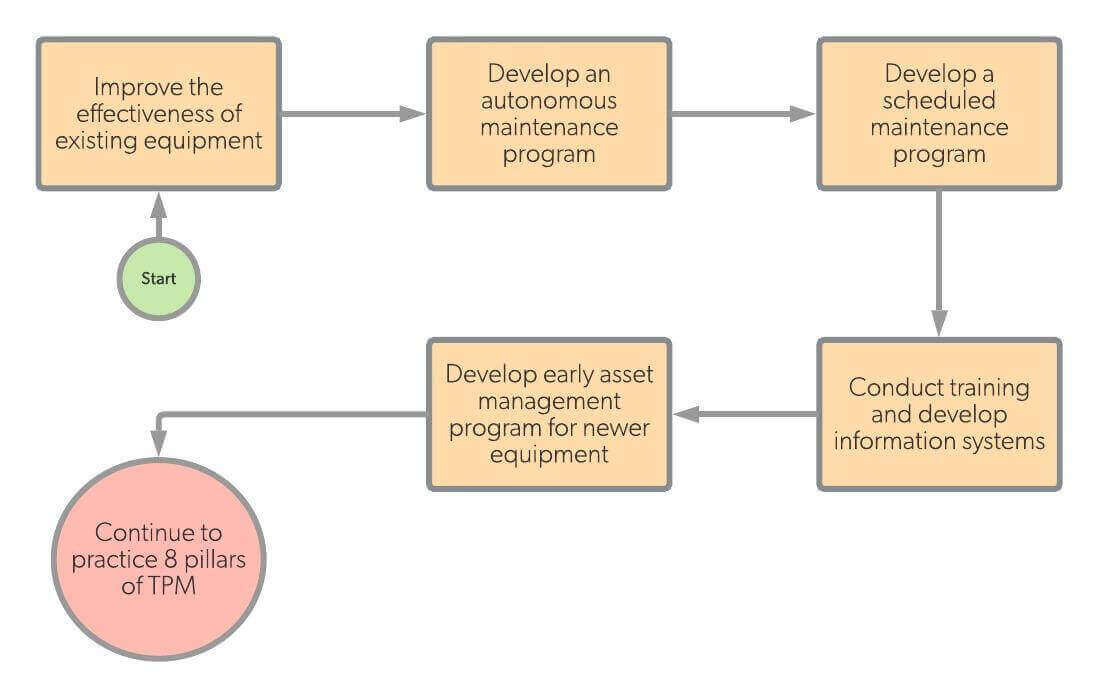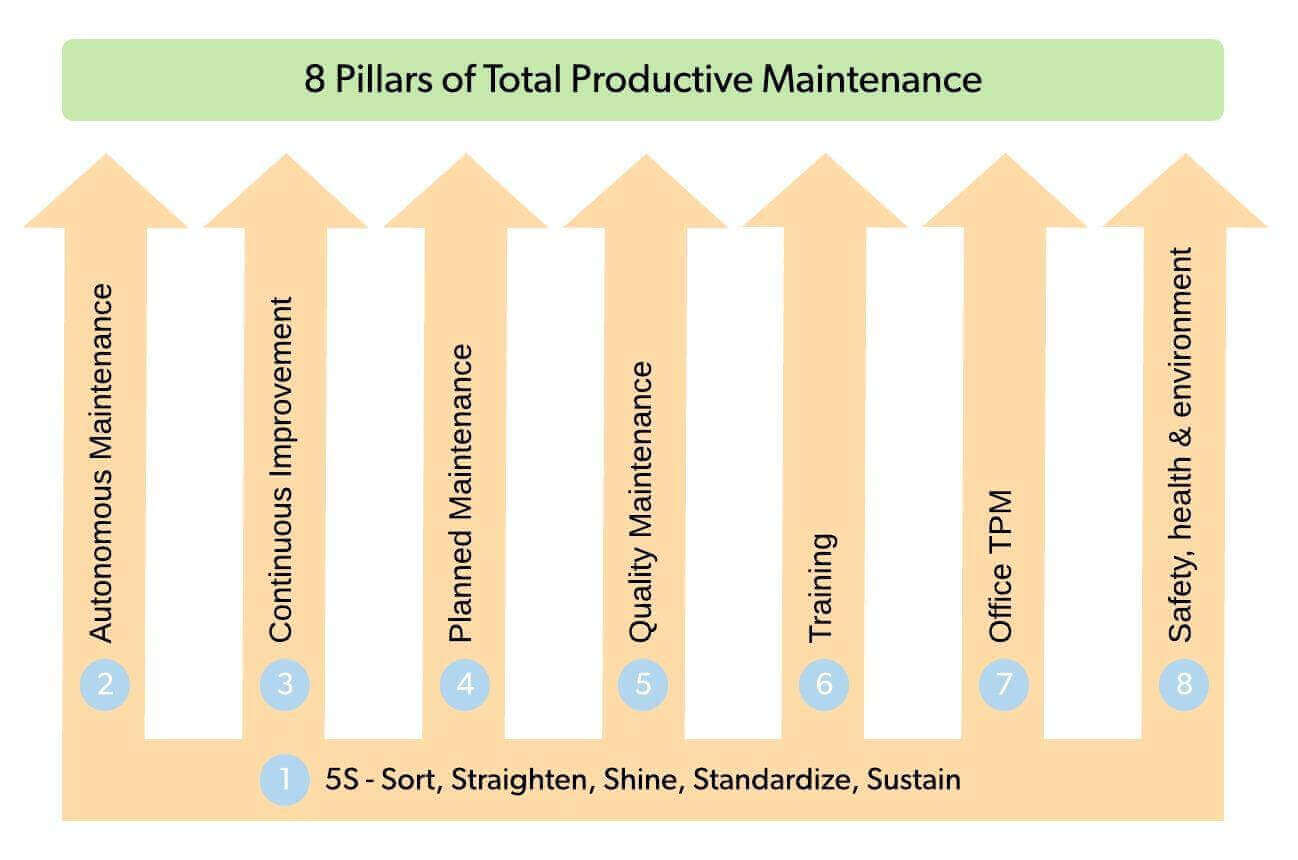Total Productive Maintenance
Total productive maintenance (TPM) is the process of maximizing equipment effectiveness through the active involvement of all supporting departments. The goal of TPM is to improve overall productivity by optimizing equipment availability.
How Does Total Productive Maintenance Work?
Maintenance, reliability, and operations workers are always striving for “perfect production.” This is very difficult since unexpected problems arise even in the best-planned facilities; however, total productive maintenance will get a facility as close as it can to “perfect production.”
TPM frames maintenance as a business advantage—no downtime and no equipment failure, meaning only production and profit. TPM is also built on the 5S methodology, which helps organize and standardize facility procedures, leading to many benefits for both production and workplace quality.
Below, we'll outline four of the most prominent benefits of total productive maintenance.
4 Benefits of Total Productive Maintenance
1. Less Unplanned Maintenance
With carefully planned and scheduled maintenance, equipment is extremely well-maintained. Additionally, TPM empowers all plant personnel to take ownership of their machines, and maintenance is a positive investment for them. Since TPM makes maintenance personal, assets are better cared for.
2. Reduced Equipment Downtime
More planned maintenance means fewer failures. By implementing proactive maintenance activities, downtime events are minimized.
3. Lower Manufacturing Costs
As overall equipment efficiency (OEE) increases, production costs are also minimized. Higher productivity leads to higher profits and reduced spending on equipment stoppage time and repairs.
4. Strengthened Workplace Safety
Because TPM is built on the 5S foundation, the workplace is systematically organized and cleaned. The steps in the 5S method—sort, straighten, shine, standardize, and sustain—uncover underlying problems and challenges to maintaining the work environment.
Total Productive Maintenance Workflow

TPM is an innovative concept in the manufacturing industry that evolved from preventive maintenance to adopt practices of productive maintenance, maintenance prevention, and reliability engineering. What we now refer to as TPM has become an ingenious approach to achieve overall equipment effectiveness by involving the workforce behind the machines (i.e., the operators).
The developments in TPM were first seen in Japan. Toyota was one of the first companies to receive TPM certification. The philosophy behind TPM was pivotal in achieving Toyota’s Just In Time level of service and reliability in their production facilities. Seiichi Nakajima, regarded as the Father of TPM, describes this philosophy in a quote: “TPM is the making of products through the making of people."
8 Pillars of Total Productive Maintenance

1. 5S - Sort, Straighten, Shine, Standardize, and Sustain
Just like a physical structure starts with a grounded framework, building a strong TPM process requires a strong foundation in the form of the 5S principles. This is a workplace organization method simplified into five basic steps:
- Sort tools, equipment, and materials to identify which of these can be discarded.
- Straighten and set things in the proper order to reduce unnecessary motion and efficiently travel between working groups and locations.
- Shine refers to performing necessary housekeeping to clean up the work area.
- Standardize and schedule activities to systematically form the habits to keep the workplace organized.
- Sustain the process and principles for long-term applications.
The 5S approach provides a systematic approach to cleaning the workplace, thereby uncovering underlying problems and challenges.
2. Autonomous Maintenance
Maintenance tasks and caring for equipment should start with the people using the equipment. Empowering operators to work on small maintenance tasks effectively allows the maintenance teams to focus on more specialized assignments.
3. Continuous Improvement
Also known as the Japanese term Kaizen, continuous improvement promotes the attitude of progressing toward zero losses and zero defects. Through small but continual tweaks to processes, the overall effectiveness and efficiency of the organization are developed.
4. Planned Maintenance
Planned maintenance activities are essential to the prevention of equipment breakdown. Planned maintenance is performed by periodically evaluating the condition of equipment to proactively prevent deterioration and mechanical failures.
5. Quality Maintenance
To ensure the satisfaction of the customer, manufacturing processes aim for zero-defect production. Standards for superior quality, and checks on whether the standards are being met, should be in place. The goal of quality maintenance is to identify any possible causes of deviations from zero-defect production.
6. Training
The idea of TPM is that everyone does their part to contribute to the overall productivity of the production process. In order to achieve optimum performance, and to build each member’s competence, proper training is required to equip each one with the theoretical and practical know-how of working with machines and equipment.
7. Office TPM
A key role that's often overlooked is the administrative department working behind the scenes. Like the rest of the production teams and processes, the management and administrative functions are also subject to productivity improvement. This includes identifying and eliminating losses and contributing to the overall performance of the plant.
8. Safety, Health, and Environment
The last of the eight pillars focuses on creating a safe workplace. The essence of this pillar is realized when actively applied to each of the other pillars. The successful implementation of this pillar will contribute to a secure and hazard-free workplace.
Total Productive Maintenance Example
The ideals encouraged by TPM are deeply rooted in the involvement of people. The main factor that drives its success is the proper attitude exhibited by the management, maintenance staff, and operators alike.
A TPM success story occurred inside one of the largest beer brewers in Latin America, Cervecería Cuauhtémoc Moctezuma (CCM). The principles of TPM, born in Japan in the 1970s, are alive and thriving in all of the company’s six plants in Mexico.
Explaining the meaning of TPM and how CCM applies it within the organization, plant maintenance manager Manuel Sanchez says, “It means we are all responsible for guaranteeing the total effectiveness of the equipment—maintenance, production, top management, human resources… everyone.”
Conclusion
TPM further develops the ideas of maintenance and preventive maintenance by involving all departments and people within an organization. With an organization-wide mindset focused on taking responsibility for the machines and equipment, increasing overall performance is achievable even with a limited number of resources.
Want to keep reading?
How would I implement a total productive maintenance program?
Total Productive Maintenance [Pillars & Benefits of TPM] - UpKeep
4 Ways to improve productivity for maintenance teams
4,000+ COMPANIES RELY ON ASSET OPERATIONS MANAGEMENT
Leading the Way to a Better Future for Maintenance and Reliability
Your asset and equipment data doesn't belong in a silo. UpKeep makes it simple to see where everything stands, all in one place. That means less guesswork and more time to focus on what matters.


![[Review Badge] GetApp CMMS 2022 (Dark)](https://www.datocms-assets.com/38028/1673900459-get-app-logo-dark.png?auto=compress&fm=webp&w=347)
![[Review Badge] Gartner Peer Insights (Dark)](https://www.datocms-assets.com/38028/1673900494-gartner-logo-dark.png?auto=compress&fm=webp&w=336)
